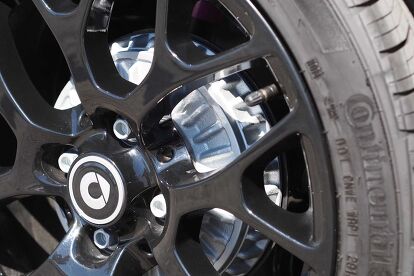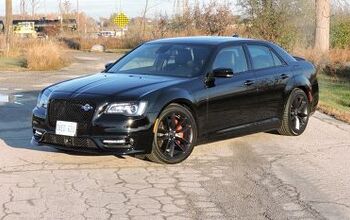2017 Smart Fortwo Cabrio Review


When car companies introduce new products, they go to stupefying lengths and spend inordinate amounts of money to present them in the best light possible.
When they invite automotive journalists to drive and evaluate new cars, they agonize over every single detail of the program, from the city the event is held in, to the color of the USB sticks handed out, to the thread-count of the sheets in the hotel, to the kinds of food served at whatever hand-picked world-renowned restaurants they eat at.
Naturally, this obsessive-compulsive specificity extends to the pavement we drive on. Automakers strive to select just the right roads — serpentine mountain highways in the south of Spain that demonstrate the athleticism of a high-dollar exotic, rock-strewn two-tracks in the Argentinian highlands that prove the capability of a four-by-four, and even Germany’s hallowed Autobahn for sports cars with a penchant for triple-digit speeds.
Appropriately, event planners at Mercedes-Benz chose the hipster hustle of heavily urban Brooklyn to showcase its new Smart Fortwo Cabrio, arguably the perfect locale for this sun-loving runabout.
Let There Be Light!
Our tour of this fashionable New York neighborhood started on an unexpectedly sunny morning. Despite the relatively early hour, it was quite warm, perfect for lowering this petite machine’s fabric lid. A push-button affair that takes just 12 seconds, you can retract it at any speed between zero and terminal velocity, which is a heady 94 miles an hour.
FAST FACTS
| Engine: | 898-cc turbocharged three-cylinder |
| Output: | 89 horsepower, 100 lb-ft of torque |
| Transmission: | Six-speed dual-clutch automatic |
| Fuel Economy: | 33 miles per gallon city, 38 highway, 35 MPG combined (Canadian figures not yet available for 2017 model year) |
| As-Tested Price: | $22,910, including $750 in destination fees (CA $30,144) |

Given its Mercedes heritage, the smart’s roof was tested to rigorous standards, 20,000 cycles in temperatures between 5 and 176 degrees Fahrenheit. Additionally, during development, it was rolled through 500 car washes to ensure its weather-tightness.

With the fabric neatly folded like a piece of Germanic origami (supposedly it’s the same premium three-layer material used in S-Class Cabriolets), my drive partner and I set about removing the cross supports for an even airier feel. These non-structural pieces clip into the windshield header and B-pillar, providing necessary support for the convertible top, if not structural integrity. Cleverly, these beam-like components stow neatly in the car’s small trunk, clipping to the hatch so they’re out of the way.

As for cargo capacity, the Smart Cabrio’s trunk provides up to 8.9 cubic feet of storage space, slightly less than its coupe counterpart, which offers 9.2. Increasing its versatility, the passenger seat folds flat, allowing this tiny car to carry unexpectedly long items.
Into the Urban Jungle
Brooklyn is a hive of activity at seemingly every hour of the day. The carefully planned drive route took us on a great variety of surfaces, from highways and thoroughfares to side streets and back alleys. This neighborhood’s battered pavement put the Smart’s suspension through its paces; some imperfections were severe enough to make even a Jeep Wrangler wince. It’s a wonder any car weighing 2,200 pounds (when equipped with an automatic transmission) could ever survive the punishment.

Our mid-level Prime-trim tester featured the optional $600 sport package, which, among other things, lowered the ride height by 10 millimeters. However, this option makes the car uncomfortably stiff. Since the Smart Cabrio is neither fast nor engaging enough to justify such starchy suspenders, the upcharge is hardly worth it.
Keeping us on the drive route was an easy-to-use navigation system. Turn-by-turn directions were provided by an Android smartphone (not included), which was held securely to the dashboard by an optional ($100) cradle. This solution may look a little kludgy, but it’s a low-cost option that works surprisingly well. Aside from running on Google-powered handsets, the Smart Cross Connect app is offered for iOS as well, which should keep Apple enthusiasts happy. An integrated navigation system with a seven-inch touchscreen will be offered in Smart models later this year.

The Smart Cabrio’s steering is quite light, but the ratio is pleasantly quick, which gives you the confidence to maneuver around cyclists, double-parked vans and, with careful planning, even slower-moving traffic. Thanks to a tiny overall length of just 8-foot-10 inches (less than one foot longer than a standard sheet of plywood), the Smart is blessed with an incredibly tight turning radius — wall-to-wall, it’s just 24 feet, trim enough to make u-turns a no-sweat operation. Too bad when viewed in profile this car looks like a bowling shoe with the toes cut off, but that’s another story.
Just Like a Porsche
In addition to rolling on four wheels and running on gasoline, the Smart Cabrio has at least one other thing in common with a Porsche 911. Just like this hallowed sports car, it features an aft-mounted engine and is rear-wheel drive. How sporty is that?
In truth, not at all. The Smart is motivated by an 898-cc three-cylinder engine that is smaller than what you get in many motorcycles. With a turbocharger huffing extra air into its engine, the car provides a thundering 89 horsepower with 100 pound-feet of peak torque.

Regrettably, in spite of its diminutive displacement, this engine is quite unrefined. At idle it feels incredibly choppy, with enough vibration to shake the windshield header. Fortunately, things smooth out completely at higher revs.
Our tester was equipped with the optional six-speed dual-clutch “twinmatic” self-shifting transmission. It cost $990 more than the standard five-speed stick, but, regrettably, it feels like a downgrade. While galaxies better than the old automated manual found in the previous-generation Smart, it’s still pretty unrefined, shuddering at certain times while taking off and jerking as you roll to a stop. It’s certainly livable, but a little more fine-tuning would be appreciated. Surprisingly, models equipped with three pedals are slightly faster in the zero-to-60-mph sprint, achieving mile-a-minute velocity in 10.7 seconds; automatic cars are nearly a second slower.

Despite peak torque coming on at a relatively low 2,500 rpm, this droptop feels pretty gutless, especially with two people onboard and the air conditioning at full blast. Bury the accelerator from a standstill and it’s a sphincter-puckering two or three seconds before anything really happens. This pause is worrisome in the cut and thrust of urban driving, especially when surrounded by hyper-aggressive New York drivers who think nothing of running timid motorists right off the road.
Pricing and Efficiency
Now, if it were priced right. the Smart Cabriolet might be a pretty compelling vehicle for folks residing in hyper-congested areas. Unfortunately, this is perhaps another missed opportunity.
You see, it kicks off at $19,650, including $750 in destination fees, which supposedly makes it the lowest-priced convertible in the country. Still, that figure seems pretty steep for what you’re getting: a car with just two seats and less than triple-digit horsepower. Adding insult to injury, our mid-range test model stickered for just shy of 23 grand!

Likewise, efficiency seems like it should be higher. In its most economical guise, the Smart Cabriolet stickers at 33 miles per gallon city – its natural habitat – and 38 on the highway. These figures result in a combined score of 35 mpg, something the 2017 Toyota Yaris iA matches.
The Competitive Problem
Though the folks at Smart think their car competes favorably with models like the Fiat 500c, Chevy Spark or even Honda Fit, it doesn’t fare well when you check the specs.
Comparing a base Spark to an entry-level fortwo coupe almost isn’t fair. The bow-tie offering is more than three feet longer, seats twice as many people and is some $1,800 cheaper; it even matches the cabrio’s highway fuel economy at 38 mpg.
If efficiency matters most, the Honda Fit is even more economical than this Smart convertible. According to the EPA, it averages 36 mpg when equipped with an automatic transmission. Of course, neither this nor the Chevy are offered with a drop top.
The Verdict: 2017 Smart Fortwo Cabrio Review
In theory, the 2017 Smart Fortwo Cabrio is perfect for young, urbanites who want personal transportation. Thanks to trim dimensions, it’s a snap to maneuver in jam-packed neighborhoods or park in spaces where a golf cart would have trouble fitting. Underscoring this, the NYPD has actually ordered nearly 150 Smarts for use in traffic enforcement, with some 70 more on the way.

Clearly, there’s a market for this kind of ultra-compact vehicle in North America, though limited it may be. For anyone living outside the five boroughs of New York or any other densely packed city, the Smart is a pretty tough sell because of its limited size, questionable value, and unusual dynamics. Folks like this would likely be much happier with a more conventional offering. I know I would.
Discuss this story on our smart Forum
LOVE IT
- Incredibly tight turning radius
- Amazing maneuverability
- Nifty convertible top
LEAVE IT
- Pricey compared to rival models
- Doesn’t feel like a real car
- Throttle lag

Born and raised in metro Detroit, Craig was steeped in mechanics from childhood. He feels as much at home with a wrench or welding gun in his hand as he does behind the wheel or in front of a camera. Putting his Bachelor's Degree in Journalism to good use, he's always pumping out videos, reviews, and features for AutoGuide.com. When the workday is over, he can be found out driving his fully restored 1936 Ford V8 sedan. Craig has covered the automotive industry full time for more than 10 years and is a member of the Automotive Press Association (APA) and Midwest Automotive Media Association (MAMA).
More by Craig Cole






















































Comments
Join the conversation
Love this car.